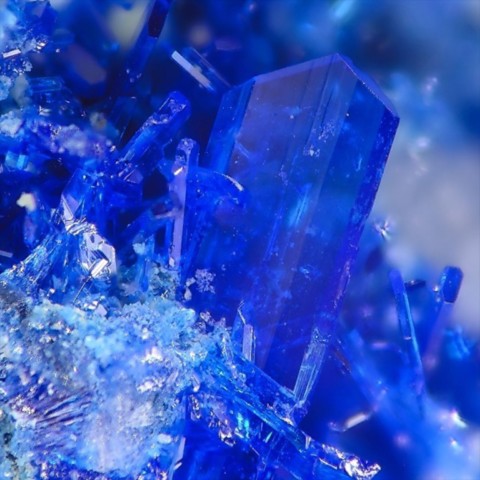LINARITE
Class : Sulphates, chromates, molybdates
Subclass : Anhydrous sulfates
Crystal system : Monoclinic
Chemistry : PbCuSO4(OH)2
Rarity : Fairly rare
Linarite is a mineral from the oxidation zone of copper deposits, where its formation is favored by the presence of galena and by slightly acidic conditions. It is also a mineral of industrial slags. Its name comes from its site of discovery : Linares in Spain. It occurs in elongated prismatic crystals, often tabular or lanceolate, isolated or in groups, in encrustations or in tufted crystalline aggregates, of a deep azure blue color. This color similar to that of azurite is probably the source of much confusion : linarite is perhaps more common than is generally admitted. It is a mineral that has no particular use and remains relatively unknown to collectors.
Main photo : 2 cm linarite from Grand Reef Mine, Arizona, USA © Rob Lavinsky
Linarite in the World
Linarite in France
In France, linarite is known in small fibroradiated groups at Argentolles (Saône-et-Loire), It is also reported in the mine of Anglais (Cantal), in Alzen (Ariège), in Chessy (Rhône), in Echassières (Allier), in Ste-Marie-aux-Mines (Haut-Rhin), in Asprières (Aveyron), in St-Laurent-le-Minier (Gard), in Peyrebrune (Tarn), in Cap Garonne (Var) and in many other deposits. It is also known in the slags of Crozet (Loire), Poullaouen (Finistère), Vialas (Lozère) and Menez-Plom (Côtes-d'Armor).
Twinning
This mineral species twins on {100} and more rarely on {001}.
Fakes and treatments
No fake recorded for this mineral species which can easily be confused with azurite.
Hardness : 2.5
Density : 5.35
Fracture : Conchoidal
Trace : Blue
TP : Translucent to transparent
RI : 1.809 to 1.859
Birefringence : 0.050
Optical character : Biaxial -
Pleochroism : Visible
Fluorescence : None
Solubility : Nitric acid
Magnetism : None
Radioactivity : None





